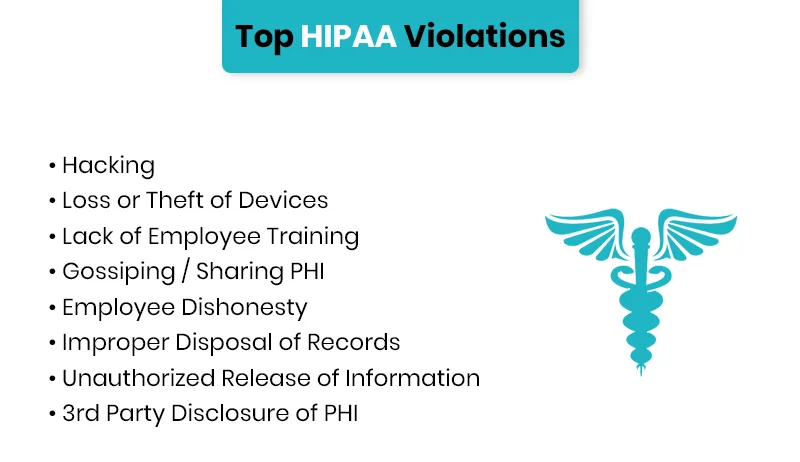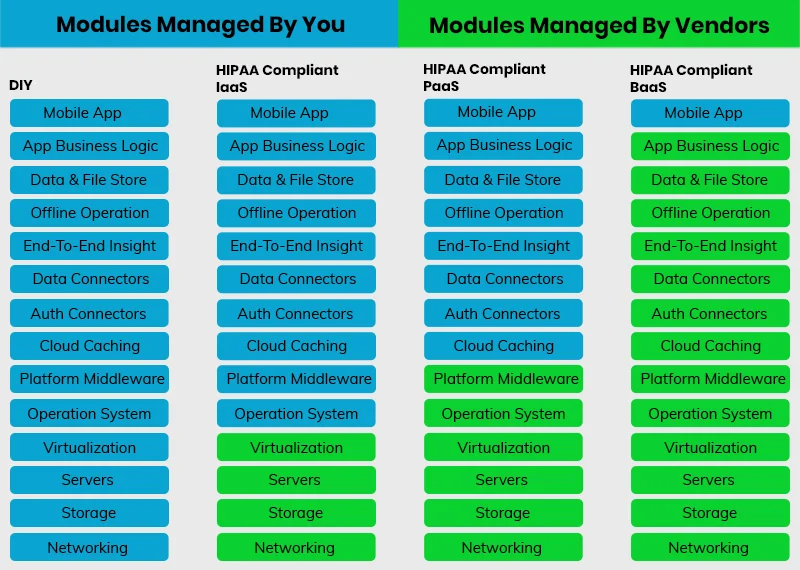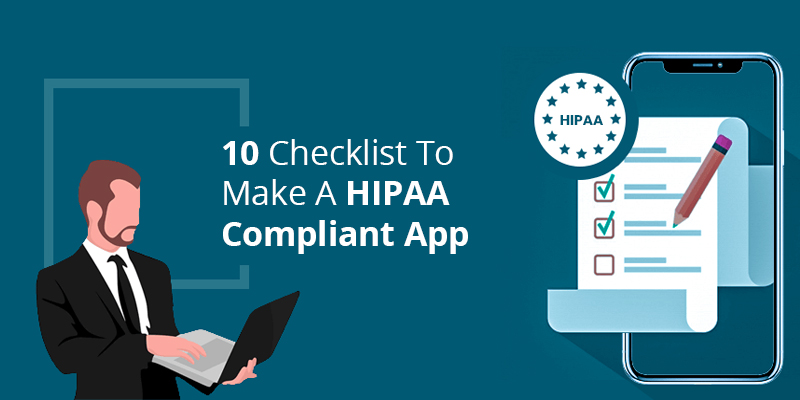So, if you’re in the medical industry, then you might have come across the term HIPAA compliant app development a lot of times.
Any businesses or enterprises like hospitals, clinics, insurance companies, or even healthcare app developers that work with PHI must adopt HIPAA compliance app development.
Why so, read the below-given details!
So, what do you remember of the year 1996? I recall Steve Jobs being called back from his 11 years of exile to rescue Apple, Google was still developing its legendary search engine, and JAVA was still at version 1. But most importantly I remember Bill Clinton signing the Health Insurance Portability and Accountability Act, also known as HIPAA.
You must be scratching your head to understand what HIPAA is. It is a federal act mandated across America for any business or organization that offers IT-based services and solutions in healthcare verticals.
Still Confused? Let’s imagine a scenario that will reveal the purpose of HIPAA.
Read Also: Telemedicine App Development: Benefits, Platforms, Challenges & Features
What Happens If Your Medical Data Gets Stolen?
What do you do if your email ID is hacked due to a data leak from one of your mobile apps? Probably, you’ll notice all your contacts and create a new ID. Well, that is fine because you can change that bit of information about yourself at any given moment.
But, what about your blood group, your allergies, and your last year’s medical expense records? You can’t change that information, and what if this information goes into the wrong hands? Then your health life is at risk to be exposed and exploited by anyone.
The question here is who will be liable in case of such information loss? Who will be responsible if there is a data breach of the user’s personal medical information? The company, government, vendor, the cloud server? Who will be brought to the court and be held accountable to answer?
These questions and the fear of being hacked was the reason the thought to create a nationwide act to protect the medical data of patients and healthcare seekers came into existence. So, HIPAA is basically the single line of defense against any type of cyber attack on a medical application, software or portal that holds health information.
The company providing healthcare app development services becomes responsible for making a web application that complies with HIPAA. In many cases, AI in healthcare app development also needs to align with HIPAA regulations to ensure patient data used by intelligent features remains secure and private.
What Is HIPAA?
HIPAA has 4 Main Purposes
- A) Privacy of Health Information
- C) Administrative Simplification
- B) Security of Electronic Records
- D) Insurance Portability
What we are concerned with in this blog are points A and B. As the title suggests, you are here to learn how to build HIPAA compliant apps, software, and devices that comply with HIPAA guidelines and regulations.
So the developers and entrepreneurs planning to develop medical and health-related digital solutions should be concerned with the data privacy that is created, stored, and transmitted via your software.
You can’t understand HIPAA without understanding of PHI (Protected Health Information).
What is PHI?
PHI (Protected Health Information) is any information about health care, medical status, and payment information for any healthcare that is created, stored, or transferred by a Covered Entity or a Business Associate that can be linked to an individual who sought the medical care.
Who Are Covered Entities Under HIPAA?
According to HIPAA, a Covered Entity is anyone who
- A) Provides Health Plans
- C) Healthcare Providers (who use medical software and app to transmit PHI)
- B) Healthcare Institutes
Who Are Business Associates Under HIPAA
Business Associates under HIPAA are anyone who collects, stores, or transmits PHI for a covered entity.
How to become HIPAA-Compliant Enterprise?
It is easier than you think. The key to becoming and staying HIPAA compliant is consistency. While you are developing your healthcare app make sure that you completely follow the technical guidelines mentioned in the act.
The technical guidelines cover the software part of the solution like activity logs, data encryption, app login, emergency access, etc. while the physical guidelines comprise the security of the data center, servers, and other hardware that work on the backend of the solution.
What are the features required in HIPAA Complaint mobile app? Let’s get familiarized.
HIPAA Compliant Feature Lists
Proper Access Control
The App needs to have a properly defined access control for its users and admins. The amount of access to the data should be restricted according to HIPAA privacy rules.
User Authentication
Proper user authentication methods like biometrics, passwords, PIN code, or cards/tokens should be set in your HIPAA-compliant app development.
Transmission Security
If your device or software will be transferring PHI over a network, then you must make sure the data transmitted over the network is encrypted with SSL/TLS.
PHI Disposal
Permanently destroy any PHI that is not useful anymore. In many instances, companies lost a fortune over such data that wasn’t even being used. You will learn more about PHI disposal later in the blog.
Secure Data Backup
Data backup is necessary for any company, let alone the one dealing with important PHI. To stay secure against server crashes and database corruption or even natural accidents like earthquakes or fire outbreaks, have secure data backups.
Responsible Audit Control
Have a responsible audit control set up for the PHI data being handled. The company must always know where and how the PHI is being accessed and used. A simple approach is to have a log file in the database of who is accessing which PHI data at a given time.
Device Security
For your HIPPA-compliant app, you must also consider device security. This can be done by adding features like full device encryption & remote data erasure. And can also be a privacy compliant that can be a layer of security to your medical app.
Why Should You Care About HIPAA Compliance For Web Applications Development?
Well, HIPAA is the government regulatory body whose work is to make sure that you create healthcare apps that are safe to use for people and is a robust solution against any cyber attack.
You need to understand that HIPAA is not a body that protects you in case of any misfortunate cyber attack. This act is only there to protect the PHI of patients and make sure that your digital health solution is safe from such attacks in the first place.
So you can’t just market your app built under PHI guidelines without complying with HIPAA. This way you are already violating the regulation. If you are the entity that owns that software or the one that built the medical software, you are legally obligated to the app users.
So the Covered Entities and Business Associates, both are liable under the HIPAA act.
Let me repeat it one last time to clear out any doubts; if you build a healthcare or medical app, website, device, or portal that creates, stores, maintains, and transmits PHI, you should go for HIPAA compliance development.
A 10-Point Checklist To Create HIPAA-Compliant mHealth Apps & Software
Understand these 10 commandments to follow when creating HIPAA-compliant mobile apps. An on-demand doctor app development or Mhealth apps for your target audience with complete compliance with HIPAA for PHI can be built by implementing these pointers.
1. Do you need HIPAA?
Make sure whether your app actually needs HIPAA compliance. For instance, if all your app is collecting calorie intake or blood pressure and heart rate, via fitness band or mobile phone, then your fitness and health startup app doesn’t need HIPAA-compliant app development.
2. Collect Only Necessary Data
Only access the information that is useful for your needs. For example, If your software needs to just learn about the medical stats of the patients then recording their medical expenses is of no use to you and simply a larger threat in case of a cyber attack.
3. Sign a BAA
Always sign a Business Associate Agreement (BAA) when you have to involve 3rd party vendors. This way even if your team is perfect in maintaining security, if a slip occurs on the vendor side, the BAA will protect you from the damage done by other parties and vice versa.
4. Keep Data Encrypted
Always keep HIPAA compliant text messaging data encrypted. To clarify, SMS and MMS are not encrypted, so don’t add these features to your medical app. Similarly, push notifications are a big no-no for such apps.
5. Set Clear Privacy Policy
Mention a clear privacy policy for the users before they Sign up. Make sure the policy covers all grounds.
6. Choose HIPAA Compliant Cloud Stack
Go for a HIPAA-compliant cloud stack for healthcare and don’t store data on Android or iOS devices. Human error can occur anytime. Leaving the device open or losing the device can put such data under threat. You can check out multiple trends in mobile app development to understand the technologies with cloud stack.
7. Dispose the Data Not Needed
Dise of the PHI that is not being used. If you clear out the information that is no longer needed, you will not be in any risk as that information won’t be anywhere to access or hack.
8. Choose the Right Development Partner
Always choose a healthcare app development company that has vast experience in building HIPAA-compliant applications.
9. Balance User Accessibility with Data Protection
You need to make a good balance between user accessibility and data protection making the app interface both safe as well as easy for the users to work with. Features like Two-Factor login, and timeout the local session in the app would comply with HIPAA as well as prove to the app users the security of your health app.
10. Find a Professional Business Analyst
Double Check the HIPAA regulations and take advice from a professional Business Analyst who can explain to you how important is HIPAA and PHI regulations for your app and what would be the cost to get the certification.

The e-book can be a perfect guide for you to understand a step-by-step process of how various technology works with healthcare.

5 Steps to Make an App HIPAA-Compliant
Understanding the steps for HIPAA compliant app development can help you create a secure system that ensures compliance and data protection. However, there are some prerequisites that you need to understand first,
Now that prerequisites are out of the way, here are key steps to build a HIPAA-compliant application:
Step 1 Secure Your Backend
Your app’s backend is its most critical component. It manipulates data and stores patient information, so you must ensure its security. One way to do this is to use HIPAA-compliant cloud service providers like AWS, Azure, and Google Cloud Platform. You can leverage cloud-computing services to ensure security and data access management with built-in features like Identity and Access Management (IAM).
Step 2 Categorize Your Data
When designing a HIPAA-compliant secure system, prioritizing sensitive data becomes essential. You must build a distinct data store for Protected Health Information (PHI). This helps isolate the app data and security prioritizations for more sensitive information.
Step 3 Leverage Encryptions And Test Your Apps
When developing a HIPAA-compliant app, get an SSL certificate to protect sensitive data. An SSL certificate scrambles the information exchanged between a browser and a server so that cyber attackers cannot access it.
Once encrypted, the app will be secure against man-in-the-middle attacks. However, you must continuously test your system for other vulnerabilities.
You can leverage automated testing tools for better efficiency and faster test execution. Some of the major tools you can use are,
Steps 4 Blend Observability WIth IAM
Next, and one of the most critical steps, is establishing logging and monitoring systems. These systems provide insights into functional errors, causes of security breaches, and any anomaly in the system. By leveraging observability principles, you can ensure better security for the systems. Plus, you can implement identity and access management policies that make sure data access is available only to authorized personnel.
Steps 5 Manage HIPAA-compliant Business Associate Agreement (BAA)
While integrating third-party services and working with vendors for different services, signing BAA becomes crucial. It ensures compliance with HIPAA with data security measures, alerts on cybersecurity attacks, and adherence to information regulation standards.
5 Tips to achieve HIPAA compliance
Ensuring HIPAA compliance for application development and securing information needs strategic efforts. Considering the complexities of HIPAA compliance requirements, here are some of the significant tips,
1. Establish HIPAA Privacy Rule Policies For Your Apps
HIPAA compliance privacy rules include adherence to “Administrative Simplification Regulations.” To establish HIPAA security rule policies and breach notification standards, you must first define the critical touchpoints where data access occurs.
Implement the rules, including a declaration to users about what type of patient data you store and how you intend to use it. Defining and applying the rules is one of the first steps to developing a robust, HIPAA-compliant mobile app.
2. Define The Roles & Responsibilities
A key role you must define within the organization is that of a HIPAA compliance officer. They train the entire workforce on key principles of HIPAA compliance, monitor adherence, and enforce key security policies.
You can even have additional HIPAA privacy officers as a single point of contact for the users and employees to report any privacy issues. These officers also conduct regular assessments to reduce risks and improve security.
3. Review BAAs
BAA is an agreement between two parties that ensures HIPAA compliance. So, if you are planning HIPAA-compliant pharmacy app development, you must ensure third-party vendors enter into a BAA agreement with you. This includes information on billing services, medical transcription services, accountants, consultants and other independent contractors.
4. Secure Data Technology
Securing IT security and data protection is crucial to developing a HIPAA-compliant app. Only authorized personnel should have access to patients’ essential healthcare data. To ensure the security of patient health records, leverage EHR development.
5. Declaration, Audits & Documentations
Declaring the fair usage of patient data is one of the pillars of HIPAA compliance, and your app development project needs to be strategic. First, ensure you inform your patients and let them access their health information.
You must also conduct self-audits of the system, ensuring no risks are involved. Scan the system for vulnerabilities, anomalies, and log errors. Document all the log errors and analyze them to reduce the cybersecurity risks and improve HIPAA compliance.
What Are The Fines If You Violate HIPAA?
After learning all this, you may think “Is going through all this trouble worth it?”. There are two responses to this question.
You should go for HIPAA compliant app development as this certification creates a powerful brand image in the eyes of medical professionals and every healthcare provider and seeker. As a result, you’ll be among the top 1% of apps that have HIPAA compliance hence the most trustworthy app solution for your users.
There is another reason to go for HIPAA compliant app development. That is to say, if you do not do so and there is a breach attack, and PHI is leaked from your mobile health application; You will be responsible and liable to pay fines as per the court orders. Further, the Civil Penalty ranges from USD 100 to USD 50,000 per violation per user.
So if there is a breach of about 500 user data, and if the court charges you a USD 1000 fine per user (if the data was not very precious) then you will end up paying USD 500,000 for such a case.

Get updates of the latest tech news
Register with your email ID to get the first bite of the most trending news.
What Will Be Your HIPAA-Compliant App Development Choice?
HIPAA is not the only regulatory body for healthcare web development. Entities like FDA, EPCS, HL7 and GDPR provide certification for companies.
However, now you know everything about why and how to make an app HIPAA compliant. Though, HIPAA can seem to be a tough and confusing body that you can’t fathom alone.
So you need a team of expert medical app developers that have worked with HIPAA before. With such an expert development company you can create your own HIPAA-compliant mobile healthcare app with ease.
Get in touch with our HIPAA compliant app development experts to get the best solutions!
HIPAA can seem to be a tough and confusing body that you can’t fathom alone. So you need a team of expert medical app and software developers that have worked with HIPAA before. With such an expert development company you can create your own HIPAA complaint mobile healthcare app with ease.
How Much Does HIPAA Compliant Application Development Cost?
HIPAA-compliant app development costs depend on app functionality, complexity, and tech stack. Here are the key HIPAA compliance application development costs.
1. Function Of Startup App
Developing a HIPAA-compliant app requires defining the key functions you can securely build by leveraging a healthcare app development expert. The cost of developing such applications can be higher with complex functionalities.
For example, developing a healthcare app for tracking patient vitals can cost anywhere between USD 25,000 and USD 70,000, with the cost of a compliant version going up to USD 85,000. Due to the complex functionalities involved, this is slightly more expensive than what a normal app development costs.
2. Tech Stack
Tech stack can significantly impact the cost of HIPAA-compliant app development. If you want to build native HIPAA-compliant apps, you must spend more. Because each platform, like iOS and Android, has a separate tech stack for building apps. Even if you decide to develop either of them to reduce the cost of development because Android alone shared 70.1% of the market in 2023. So you can’t just ignore either of the operating systems.
However, you can develop a cross-platform app that uses a single codebase across platforms. Cross-platform apps also have costs.
3. UI/UX Design Cost
Designing your HIPAA-compliant application requires consideration of user-friendliness, ease of use, and accessibility. A key factor is ensuring a responsive UI to avoid unauthorized transactions on the app. Non-responsive apps can lead to phishing attacks and security breaches.
Designing a secure mobile application for the Android platform can cost USD 18,000 to USD 25,000. The app design cost for the iOS platform ranges from USD 18,000 to USD 25,000.
4. Location Of The Development Team
The HIPAA-compliant app development process requires an expert to ensure streamlined activities. It leads to faster, secure, and scalable mobile app development processes. However, when calculating the cost of HIPAA-compliant applications, the location of the development team you hire makes all the difference.
For example, hiring an app developer in the USA can cost above USD 90 per hour. At the same time, developers in India can charge above USD 25 per hour.
| Location | App Development Costs |
|---|---|
| USA | USD 90/hour and above |
| UAE | USD 35/hour and above |
| India | USD 25/hour and above |
| Australia | USD 45/hour and above |
Frequently Asked Questions
No specific certification is needed for developers of HIPAA-secure applications, but they must understand HIPAA requirements for protecting patient data. Organizations should conduct risk assessments and implement safeguards.
Although no central certification exists, developers are encouraged to pursue HIPAA training and work with legal and compliance experts to ensure compliance with technical and administrative safeguards mandated by the regulation.
Health apps differ in functionality and target markets, affecting HIPAA compliance requirements. Compliance is necessary if the app handles protected health information (PHI), particularly for healthcare providers, insurers, or vendors.
Telemedicine, billing, electronic health records, and patient management systems often trigger HIPAA requirements. In contrast, wellness apps that don’t share PHI may not require compliance but must protect user privacy and data security.
Healthcare applications must comply with HIPAA when handling, storing, or transmitting protected health information (PHI) for covered entities like healthcare providers or insurance companies.
Compliance is mandatory if the app allows for PHI communication, processing, or patient access to sensitive medical data. Even apps that don’t directly store or transmit PHI may trigger compliance if they interact with covered systems or collect identifiable health data from users.
Developing a HIPAA-compliant app requires following essential rules: the Privacy, Security, and Breach Notification Rule. The Privacy Rule governs PHI usage and sharing, necessitating users’ consent for specific disclosures. The Security Rule mandates safeguards for electronic PHI: administrative, physical, and technical protections.
Developers must also prepare for data breaches by developing policies to detect, respond to, and notify affected individuals. Collaboration with legal and compliance experts is essential to ensure app functionality meets HIPAA’s strict data protection requirements.

Article By
Mayur Panchal is the CTO of Excellent Webworld. With his skills and expertise, He stays updated with industry trends and utilizes his technical expertise to address problems faced by entrepreneurs and startup owners.






